Introduction
In your experience dealing with weed do you understand the difference between a gram and an ounce? The purpose of this article is to clear up the confusion of measuring weed in the legal cannabis world and to get the basics down pat for many regular marijuana consumers, especially the new ones on the block. Whether it is to be consumed by dinner parties, shared with friends or as part of a massive order, the thing that really makes all the difference is knowing how much there is and how much it costs. This guide stands beside you to explain the commonly confusing and often convoluted metric system of the cannabis industry so that you do not make decisions blindly. Starting from grams of cannabis up to ounces, along with other forms of measurements that are in use today, this article will give information on these measurements and their background.
The Historical and Cultural Context of Weed Measurements
The Cultural and Historical Significance of Weed Measurements
The act of measuring cannabis has been part of societies’ society and has always been measured over time. Going way back into the early civilizations up to the contemporary dispensary, how the weed is weighted has been forcing certain practices that according to region, culture, and even methods of consumption.
By and large, in many cultures, cannabis was traditionally quantified in locally specific methodologies that reflected the imminent agricultural system. For instance, cannabis was exchanged in Indian subcontinent in terms of weight measurement that is prevalent with agricultural produce such as seers and tolas. These measurements not only helped in trade but also rationalised use of cannabis in these societies.
When the use of cannabis started to spread across the globe, the yardsticks of assessment also started changing. For example, in the United States, measures as the eighth (3. 5 grams) became popular within the twentieth century and with the appearance of recreational cannabis use, particularly in the subculture movements. This shift was not a shift in convenience alone, there was an added advantage of standardization, so that consumers could communicate their wants within the community.
Case Studies in Cannabis Measurement History
There is no better example in the history of measurement of cannabis than the adoption of the eighth as a common unit of measurement in the United States. The adoption of the eighth was mainly as a result of the illegality raw cannabis trade during the early prohibition period. One of the most national points that dealers and consumers realized was the fact that it is easier to subdivide an ounce into more manageable parts and that these parts should be eight in number. This standardisation made transactions easier and gave the consumers more clarity as to what they were buying.
Thus, the eighth permanently entered the cannabis consumer culture as a norm inherited from the black market to the legal one under the pressure of the increasing legalization of the plant in various states. This transition gives an indication of how some historical practices pertaining to the handling of Marijuana are evident in the current practices in the market. The practices of the eighth also impacted the price structures and the patrons’ expectations setting a precedent that is present in dispensaries today.
The Origins of Weed Measurement Standards
The standard measurement used with cannabis such as grams, ounces and pounds have their antecedents in the established measurements in agriculture not to mention trade across the world especially where cannabis had been grown. We use grams and kilograms and these terms originate from the metric system that prevails in Europe among other continents. When the selling of cannabis started getting internationalized, the mercantile system of measurement offered precision hence being adopted all over the world.
On the other hand, ounces and poundages have a royal background and were used in the United States as well as in the United Kingdom. As cannabis industry progressed in these regions, the influence of imperial system complied these units for day to day transactions.
In the course of time, such measurements standards became accepted norms in the industry which gave rise to a standard that was accepted beyond the local practice. In the present time, regardless of whether one is in a dispensary in California or a cafe in Amsterdam, grams and ounces regarded as units for measuring cannabis to help consumers across the world to understand the quantities and sizes of what is available for use in the market.
Understanding Weed Measurements
What is a Gram of Weed?
There are additional measurements which include a gram as this is the smallest units currently used in the commerce of marijuana, which is equal to 1/28th of an ounce. This is a regular practice that many consumers begin with, especially the ones that are just starting with the substance or are just buying in moderate portions. One gram usually gets one or two joints, depending upon the size of the joint and how the joint has been rolled.
Approximately, one gram of weed is big enough to fit in the size of a small grape while is small enough to be considered equal to the size of a large marble. In terms of portability the item is quite small which is convenient for the buyers who prefer to learn the taste of different kinds of marihuana without buying a big portion. A gram is also perfect for those who like to microdose or those who would like to take cannabis in moderation.
Essentially, its value reduces the level of comparison to an extreme degree as compared to other units, a gram is as simple as it can get. Hence, it is a baseline measurement that is usually used to inform consumers about other quantities that are much larger and therefore is commonly used in the world of marijuana.
What is an Eighth of Weed?
An eighth of weed which is also called an eighth is one of the most used measurements and it refers to 3. 5 grams. It is known that this quantity is particularly popular among the buyers because of the reasonable proportion of the storage space and its cost. An eighth can usually get you about seven to eight joints or several bowls if that’s your preference of a pipe or bong.
It can therefore be seen that the eighth form can be associated with the factors of low cost and utility. Its price is set in a way that it is cheaper to buy it in bulk than individual grams and at the same time it isn’t large enough for the casual user. An eighth of marijuana can sell for between $20 and $60 depending on the quality and location of where it is priced.
This quantity is best suitable for normal users with no need to take the product every day, and still one can comfortably take a week or so before the quantity is depleted. An eighth is also good for people who switch between the different types of strains because it is not necessary to buy a bulk of a certain type if you are not sure that it will suit you.

What is a Quarter of Weed?
A quarter of weed, or “quarter ounce” is 7 grams. This is because it is cost effective for more frequent users who wish to purchase a larger quantity to cope with the stockout probability at a given price. One quarter ounce can produce as much as fourteen to sixteen joints and is therefore suitable for people who like to have a steady supply of the substance.
When it comes to the economy point of view, buying a quarter is cheaper than when you buy grams or eighths. The price of a quarter ounce can cost you $50 to a maximum of $120 based on the quality of the strain and the market rate.
A quarter is also practical because it is an amount that is not so large that much attention has to be paid as to where it is stored. But it is still recommended to keep it in an airtight container to keep it as fresh as possible especially if you don’t intend to use it up all at once.

What is a Half of Weed?
A half ounce of weed, or ‘half,’ weighs 14 grams. This amount is appropriate for those who shall frequently use marijuana and would wish to be certain that they would have enough for at least a couple of weeks and even more if needed.
The second reason is that buying a half an ounce is cheaper, as most of the dispensaries have a price break for a bigger amount of the product. It ranges from $90 to $220 for a half ounce depending with the quality of the product and place of purchase. As such it is ideal for those who use cannabis frequently and seeks to acquire it in bulk to help them save costs.
The storage of a half an ounce of it is very essential to ensure that it does not deteriorate. Storing the weed in a sealed tin and keeping it in cool, dark and dry environment will ensure that its quality of does not deteriorate. Those who do not eat fast can also benefit from purchasing a humidity control pack as well as other necessary items.
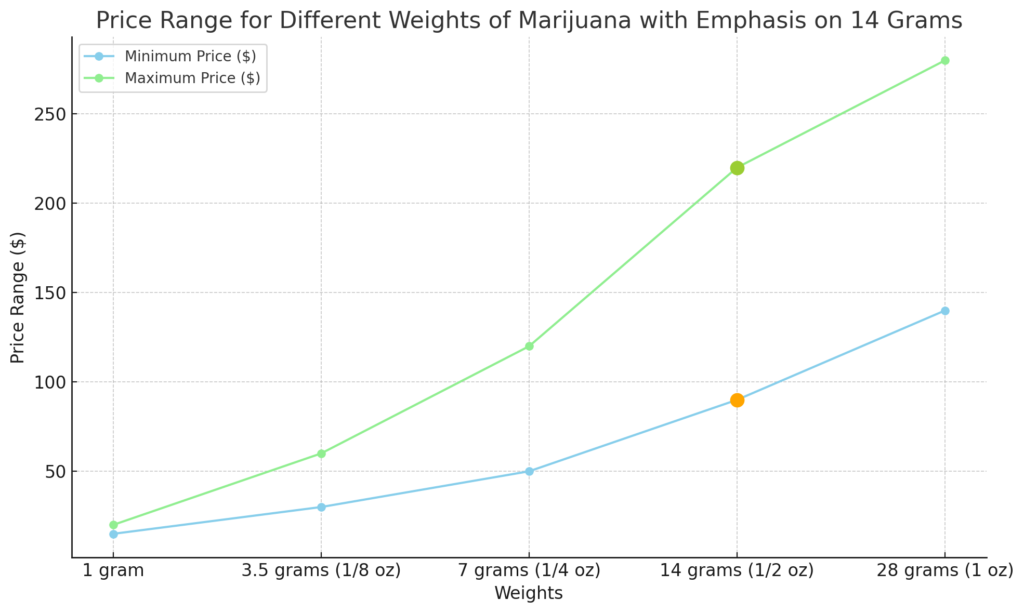
What is an Ounce of Weed?
One ounce of weed, which is 28 grams, is the amount that many states let people buy or have at a particular time. This quantity is preferred by the large consumers or those who intend to share a bottle with other people, for instance during parties etc.
An ounce means a lot, you can get between 40-60 joins if the parts are relatively small. It is also mostly picked by people who wish to order an adequate amount that they are guaranteed will last them for quite a long time as this option generally avails the cheapest price per gram. Prices for an ounce may vary between $150 and $400 and does not sufficiently depend on the quality and strain of the product.
In terms of the law, possession of an ounce is usually the maximum in those states where the use of cannabis has been legalized. Anything beyond this can attract legal implications hence the need to stay informed on the laws of the specific region. It is important to maintain an ounce value and as such most people prefer storing it in vacuum sealed containers in order to retain its quality.


What is a Pound of Weed?
A pound of weed is equal to 16 oz or 448 grams, this mass is commonly used in business or growing operations, and other massive consumers. This is actually a huge quantity that cannot be consumed by anyone consumer and it is usually in large shipments of cannabis that are distributed in bulk.
Pound of weed can cost anywhere between one thousand to three thousand dollars or even more based on factors including but not limited to strain, quality and the market price. Those in the industry make a large number of purchases by the weight which results in a big saving per gram this is why the wholesale business mostly use this unit of measurement.
In legal terms these quantities are usually reserved for only those in possession of a license to deal in the substances. Owning such a large quantity may lead to very hefty fines or, in some cases, imprisonment especially for individual consumers. Storing a pound means a lot of thinking in terms of handling, so that it does not spoil or get degraded.
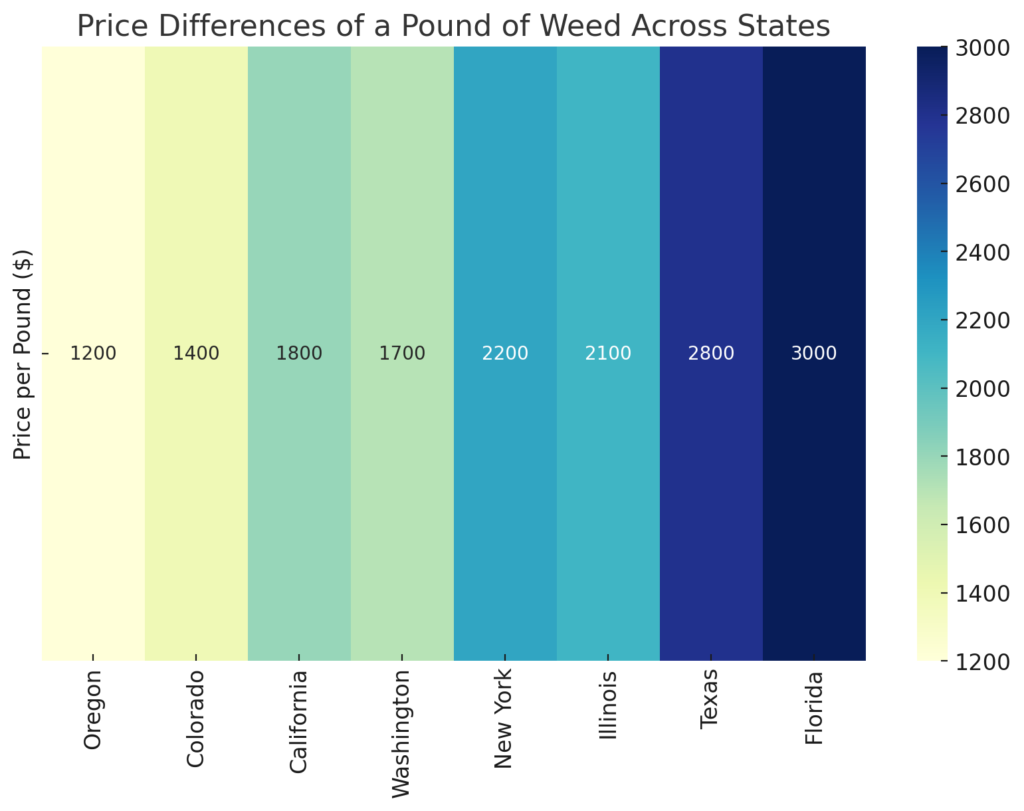
Prices of Weed Measurements
Price of a Gram of Weed
The price of a gram of weed has been observed to differ depending on the area of purchase, the quality of the Marijuana and the demand in the region. A gram of weed, on average, goes for between $8 and $20 in the United States if the ordinary consumer is to be believed. Where there is a legal use and a well-developed market, it is usually below the average, for example, in California or Colorado. On the other hand, prices may be comparatively higher in areas where cannabis remains prohibited or where its consumption is fairly recent or in places where sale of marijuana is legal but supply chains are not yet fully developed.
The cost of consuming one gram of weed depends on different elements. Quality also plays a significant role; premium strains which are usually referred to as ‘top shelf’ or ‘exotic’ strains cost more as they are of the best quality, have higher THC levels and are grown under the best conditions. Thirdy, taxes from different regions and local regulations may affect the real price on a particular product. Due to high excise taxes in some of the states, consumers may be forced to pay high prices for both the mid-grade as well as the low-grade cannabis. Consumer preferences and purchasing power, variations across the seasons as well as competition between the dispensaries within a given region may also lead to price differences.
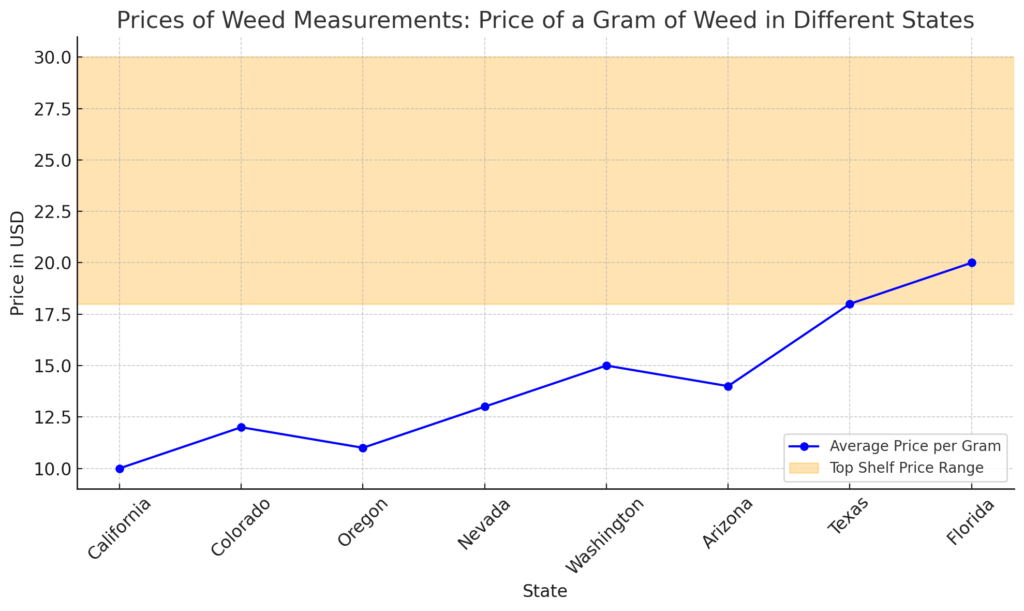
Price of an Eighth of Weed
An eighth of weed, or 3 grams of weed is the minimum amount required to bring one into the narcotics zone. 5 grams, usually costs cheaper per gram than buying separate grams. The price of an eighth goes for $25 to $60 for an eighth, varying with the quality, location as well as demand and supply in the market. Eighths ‘price can range from the low end, more often seen in mature markets such as Oregon, up to significantly higher prices in states with a more recent change in the laws or with higher demand.
It is possible to observe significant changes in the prices for a eighth of weed throughout the year, which are only amplified during the holidays or the dispensary’s specials. Some people close their business during the holiday implying that it’s cheaper to buy products during the holiday because many businesses compete in order to attract customers. However, in other periods, prices are likely to be constant, as is the case with highly demanded premium strains.

Price of a Quarter of Weed
A quarter ounce of weed, or 7 grams, should set a consumer back anywhere between 50 and 120 dollars buy making weed at home: a tutorial, depending on quality, quantity, and demand. A quarter again comes at a lower price compared to smaller amounts such as grams or eighths; hence it is cheaper than daily consumption by marijuana users.
Purchasing in chunks such as in a quarter ounce not only means getting cannabis at a cheaper price by the gram but also means you wouldnt have make quite as frequent a trip to the dispensary especially if you consume constantly. Also, there are discounts for bulk purchase, or one can get a chance to join a sort of VIP-club of the dispensary. But the rate at which the weed will be sold is also a factor that needs to be addressed because the weed may turn stale and thus would be less valuable.
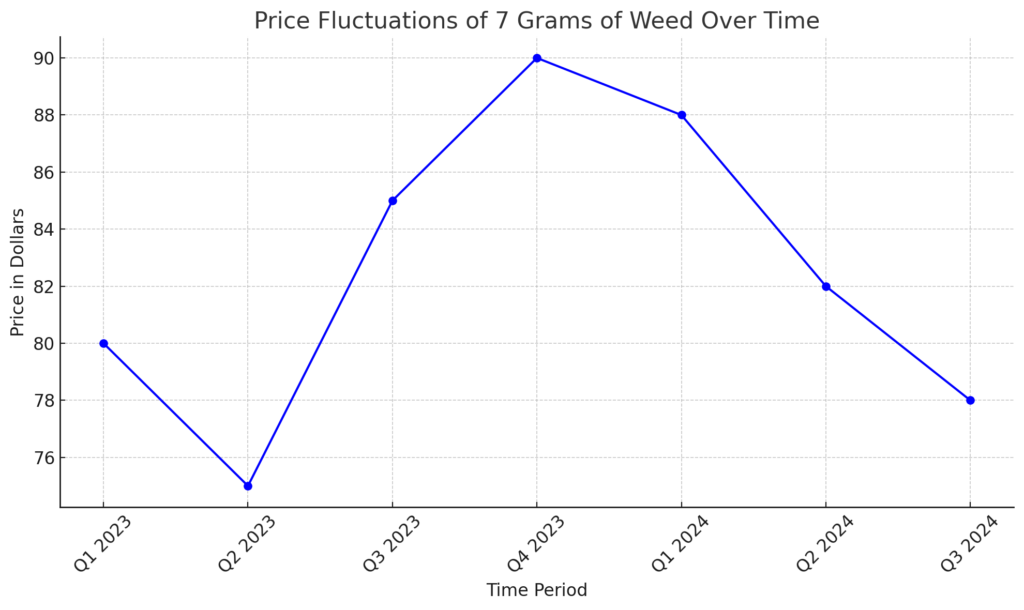
Price of a Half of Weed
A half ounce of weed, this is 14 grams is affordable at between $90 and $220. This quantity is preferred especially by those who often use this product since, it can be cheaper and more convenient to have a higher amount. Another benefit of a half-ounce is that, due to the fact that the price per gram is normally higher than for half an ounce, it can be cheaper in the long run for someone that frequently uses cannabis.
When buying a half ounce one needs to be conscious of the quality of the strain as well as how often they use the substance. It goes without saying that the premium kinds will have a higher cost, yet they may also have better quality, which may imply that fewer products have to be consumed to achieve the wanted impact. Also, half ounce of this substance has to be stored properly because if not, it becomes impossible to have fresh marijuana, but rather, dried out or stale one.
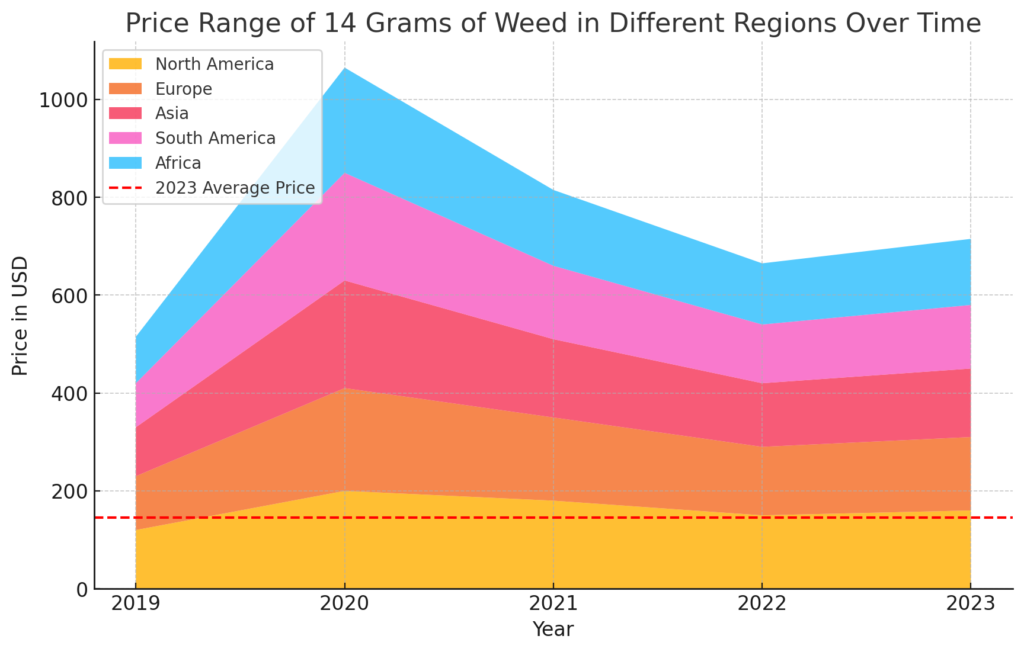
Price of an Ounce of Weed
A single ounce of weed, which translates to 28 grams, can range between $150 and $400, depending on aspects, such as the given strain, its quality, and the area’s market. For consumers who on the other hand use the products a lot or who usually purchase in wholesale an ounce is the most economical offer per gram. An ounce is much cheaper than any other quantity; however, this is vital for those who really like and who use the product frequently visiting the dispensaries.
Now when going for an ounce, there is important to consider both premium and economy segment. Premium choices may be a bit expensive but its essence introduces unprecedented results, taste, and quality to the product. On the other hand, budget constraints might provide more value for those that consider the quantity to be more important than the quality. If consumers are still not ready to pay the high price per gram they should consider buying on sale, buying in bulk or sharing an ounce with friends to save money but at least get cheap cannabinoids.

Price of a Pound of Weed
A pound of weed, which is 16 ounces or 448 grams, is mostly concern to dispensary or growers or those users who have a huge amount of consumption demand. The cost of the pound can easily vary between $1000 and $3000 or even more with regard to quality, type of straining and various other factors that influence the demand on the market. Buying weed by pound means that the amount that you are going to spend per gram is going to be greatly reduced which is why it is common to see business people dealing in marijuana or serious stoners making this kind of purchase.
Price in bulk comes with factors such as: The legalisation of cannabis in the region, cost of production and the market supply and demand. As for prices, they can be almost nonexistent in states which produce too much marijuana per year with a pound costing up to $1,400 in the states, where demand is much higher and available legal supply is scarce. Another factor that cannot be overlooked when buying such large quantities is that if not well handled there are legal consequences as well as transportation and storage implications that are very effective in depleting the value of the obtained goods.
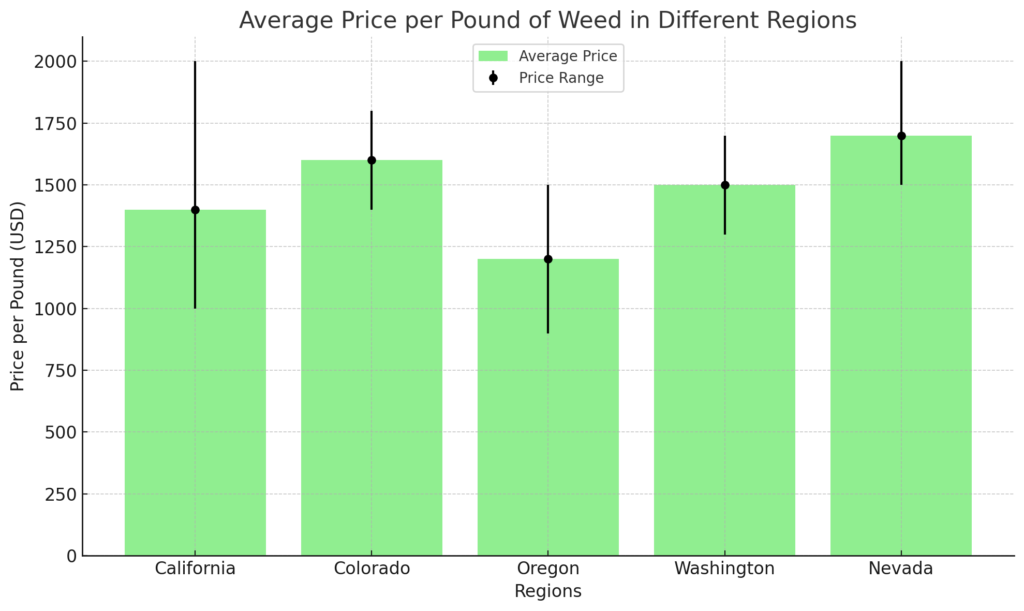
Price Comparison Across States
The price of weed is more or less determined by the law of demography, where the price of weed differs from state to state depending on the laws in those states, taxation policies and the level of maturity of the cannabis market. For instance, the prices are low in such states like Oregon and Colorado due to higher competition and effective supply demands. On the other hand, depending on the state and the policies toward new formations and renewable resources are less liberal such as New York or Illinois the cost can be considerably higher.
The research also proves how legal states with low tax rates and less regulation tend to offer cheaper cannabis. Conversely, the states that have high excise taxes as well as restricted dispensary outlets record higher prices. Also, the level of competition realised in the local market matters greatly, more so due to the fact that increased competition leads to lower prices from various rival dispensaries.

Expected Price Trends for 2024
Some of the factors that may lead to the changes of the cannabis prices in the future which is 2024 include: New legalization laws within America and other countries could further increase the availability of the commodities common in some areas may see the prices reduced. However, various market forces such as increasing production costs, changes in laws and the public’s preferences may hinder this process in the various regions.
Due to the continuous growth and development of legal cannabis markets, with menacing competition pushing for lower prices thus provoking more fluctuations in prices. Also the introduction of new strains and products could distort the pricing since consumers will be willing to pay for something new or better than what was previously available in the market. In conclusion, one may consider that, having reached a certain level of market development, prices for it may remain at the same level or even decrease, while in other areas of the world there may be fluctuations due to local peculiarities and trends in the cannabis market.
Legal Considerations for Weed Measurements
Regional Legal Differences in Weed Measurements
The regulations of the permissible amounts of cannabis also differ from one jurisdiction to another hence affecting the amount legally allowed to be bought, owned, and consumed. Such differences are usually due to the legal and social conducts of a state, and the degree of cannabis legalisation in the region. It is therefore important for the consumer to understand such differences, since some ingredients if produced above the legal limit, can get one into severe trouble including facing fines, legal cases as well as imprisonment.
In countries where cannabis is legalized fully or partially like the part of North America and part of Europe legal restrictions are normally liberal, and people are allowed to possess large quantities of the substance. On the other hand, for the countries where cannabis is still prohibited or where its usage is allow to certain extent only, the quantities allowed are considerably lower and this has to do with the fact that the substance is still tightly regulated. The implication for consumers are the following; understanding these laws ensure that people who consume cannabis do this with out putting the law into consideration.
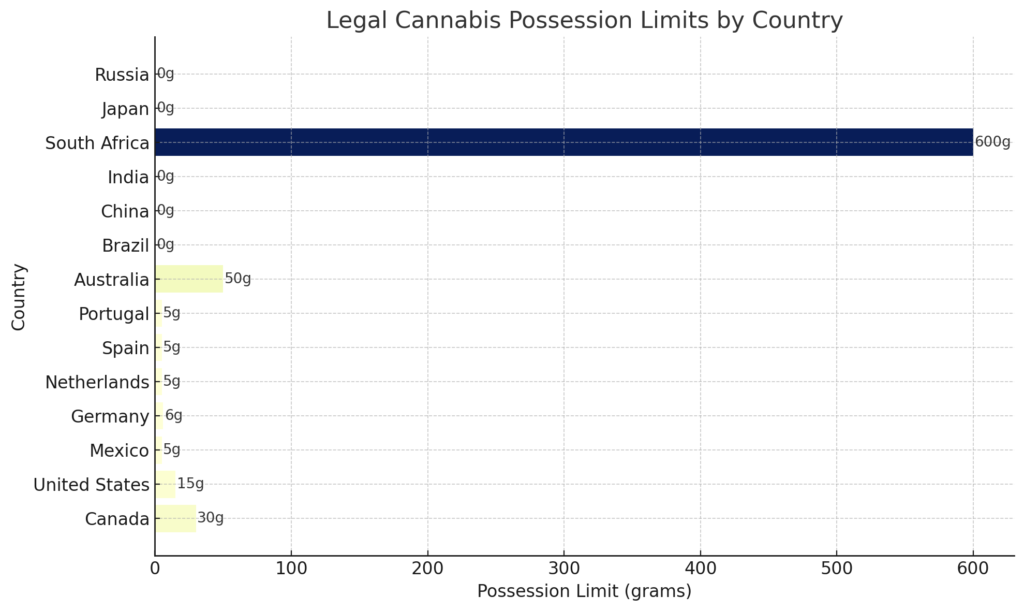
Legal Limits in North America
Cannabis has a complex legal status in North America, which currently includes two countries: Canada and the United States, with the status within the latter highly differently on a state level and, to certain extent, even within individual provinces for Canada. Cannabis laws are mainly organised on the state level in the United States of America making it to have many gaps in the entire nation. For instance, while in California and Colorado one is allowed to possess up to one ounce of cannabis if he or she’s an adult of 21 years and above. Some states may permit the use of up to two ounces in personal use as is the case of Oregon. But the transport of this product across state borders, even between two legalized states, is still unlawful according to federal law.
Canada, for instance, has legalized cannabis countrywide through the Cannabis Act that allows a person above the required legal age to hold up to 30 grams of the product or the equivalent of cannabis in other forms like edibles and concentrates. The law is centralized, but each state and territory may have their own laws on top of the country’s legal system which may for instance include where one can use cannabis or how it can be disposed in a car.
Such legal requirements are meant to address issues with health and safety on the one hand and liberalization of freedom and use of cannabis on the other, and they fall in tune with the levels of tolerance toward cannabis in North America. This is significant because consumers need to know the limits of their devices so as to not be guilty of criminal offences by accident.
Legal Limits in Europe
Europe has a rather complicated legal perspective of cannabis and its use, and laws in different countries differ a great deal. In some of the European countries for instance Netherlands , Spain it is legal to possess small amounts of cannabis for personal use. In the Netherlands for instance authorized adults can carry up to 5 grams of marijuana and grow to 5 marijuana plants. Nevertheless, cannabis is still technically prohibited in these mostly permissive countries, and its sale is legal only with certain conditions.
On the other hand, there are countries such as France and Sweden where cannabis is prohibited and its use attracts severe consequences. In these regions merely possessing small quantities of cannabis can attract fines, mandatory Drug Education or imprisonment. But nowadays there is a trend across Europe to change the viewpoint on cannabis use, with several countries that are planning to decriminalize or legalize cannabis in the nearest future.
The legal structure of the Europe entails that the consumer should be very careful especially because the consequence for possessing the substance may vary from one country to another. It is imperative that travelers going to the European countries must learn the laws governing the countries they intend to visit since the law that allows a certain act in one country could lead to severe consequence in the other country.
Legal Limits in Asia-Pacific
The Asia-Pacific countries are some of the most restrictive concerning cannabis in the entire world. Possession of cannabis is prohibited in many countries and even in some parts of Asia, such as Singapore, Japan, and South Korea, mere possession of small quantities of cannabis can attract severe penalties way beyond what is generally acceptable in the western world such as lengthy imprisonment or even the death penalty in certain circumstances.
On the other hand, the governments of Thailand and Australia have recently started decriminalizing cannabis even though the governments give very strict conditions behind it. For instance, Thailand has legalised cannabis for medicinal purposes, and although the country’s patients licensed to use cannabis can possess it in limited amounts of the drug, this is under the supervision of the government. Currently, cannabis for medical use is legal in all Australia, but for personal use it is still prohibited although penalties vary in all the states and territories.
The legal regime within most of the Asia-Pacific countries remains rather rigid, which makes consumers extremely cautious. Although the use of medical marijuana is legal in most areas of the world, the legal measures enforced are always strict and failures entail legal consequences.
Buying Guide and Market Trends
How to Ensure Accurate Weed Measurements
This is important for the sake of ensuring that the outcomes of the weed measurements are accurate for the benefit of both the buyer and the seller so as to avoid running into disagreements. Here are some practical tips for consumers:Here are some practical tips for consumers:
- Use a Reliable Scale:Use of a high quality digital scale is the best method of checking the weight of your cannabis purchases. Make sure the scale you will choose uses grams as the units of measurement or something finer than grams, and ensure that the scale is at least the fourth decimal point finer. 01 grams. This is important so as to be guaranteed that what one is paying for is what they are receiving especially when dealing with relatively small batches.
- Understand Labeling:When acquiring the products at the dispensaries they are usually tagged with labels showing the weight, strain and the potency. Knowing about these labels can assist you to confirm that the product that is on the supermarket corresponds to what you have bought. One should ensure that one checks the net weight which is often printed on the packets before manufacturing the product and compare it with the weight written on the scale.
- Check for Consistency:Consistent weight in pre-packaged cannabis products also has to be taken into consideration when purchasing it in the market. If you see anything odd or you pay and use it and realize there is a problem related to it, report this to the dispensary staff or approach another vendor.
- Know Your Rights:Many places that cannabis is legal will have consumer protection laws that demand the proper labeling and weight of cannabis products. It will help you identify with these regulations so that your purchases conform to the regulations of the local country.
Tips for Buying Weed by Measurement.
If buying weed, then one should get it in a quantity that he or she can consume, store and in a price range that they can afford. Here are some tips to help you make informed decisions:Here are some tips to help you make informed decisions:
- Start Small:Beginners or if you are experimenting with a new type of cannabis then, it is wise that you take small servings of about half a gram or one eighth. This means that you can use the product for a trial while incurring minimal costs thus providing a good position to invest in suitable structures.
- Consider Consumption Habits:Any user may also find the value in buying larger portions like a quarter or half an ounce. In the long run, this method helps one to save money while also guaranteeing them a steady stock to supply. Occasional consumers, however, may be satisfied with small amounts in order not to harm the weed and it gets spoiled.
- Think About Storage:Cannabis should be stored away from light preferably in a cool place and should be stored in an airtight container for it to have the required shelf life. For bulk orders you may need to ensure that they are properly protected to help minimize on cases of degradation. You can also take your time to opt for humidity control packs which can go a long way in maintaining the quality of the weed.
- Budget Wisely:Bulk products are majorly cheaper in the sense that they are cheaper per gram but one would be required to make a large investment. Ensure that your budget is in harmony with your consumption requirements so that you do not buy more than the requirement with a risk of expiring before you can even use it.
Current Market Trends in Weed Prices
The cannabis market is rather volatile, which reflects such factors as floor and ceiling prices, ownership and legalization, and new consumer trends.
- Shifts in Demand:Many people now use cannabis, and there is a push toward getting strains that are of superior quality with more attention being paid to the process of cultivating the plant. This shift is leading to increasing the cost of the specialty strains while the traditional cultivators remain cheap.
- Price Changes:Through harvest cycles, changes in weather and conditions that affect growing and regulation change, the price has the tendency to fluctuate a lot. For instance, in more developed markets such as Oregon and California, the oversupply phenomenon has in some way precipitated prices slashes while in relatively less known and hence accessed markets, there tend to be higher prices because supply is known to be significantly less.
- Emerging Products:Former flower prices are affected with the recent introduction of new cannabis products in the market that include concentrates and edibles. During this period the cultures transforms to these and this will reduce the prices of specific plant species in some of the segments that consumers explore.
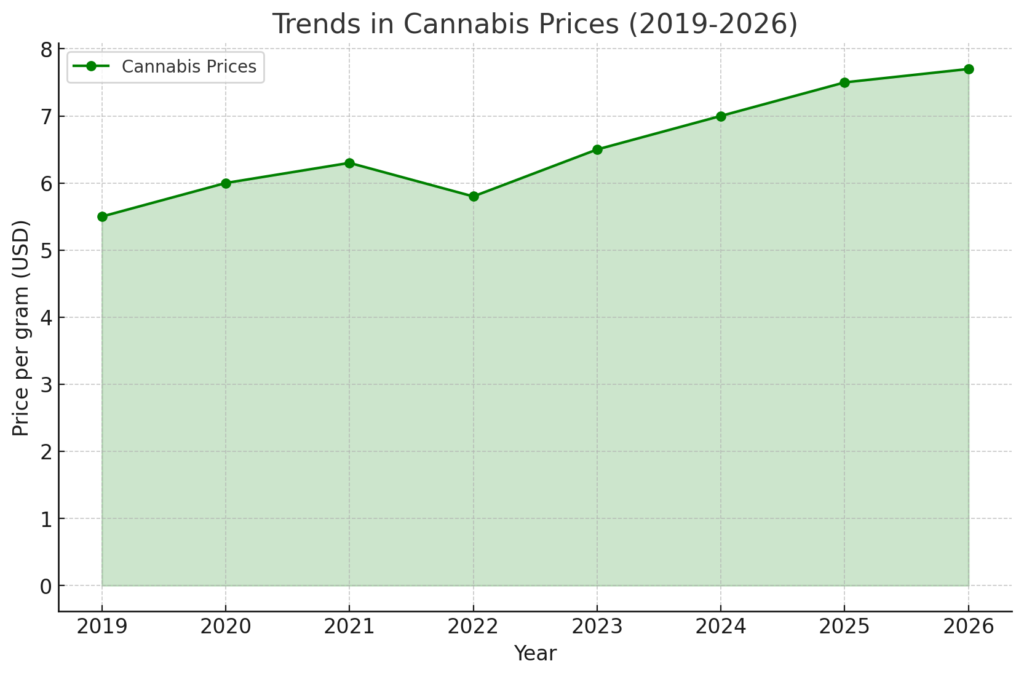
Cutting-Edge Technologies in Cannabis Measurement
Equipment Technology is changing the ways of the measurement of cannabis, packaging, and its consumption. These innovations ensure greater accuracy, efficiency, and transparency in the cannabis industry:These innovations ensure greater accuracy, efficiency, and transparency in the cannabis industry:
- Digital Scales:Digital scales with high-precision are no longer considered as addition accessories for dispensaries, but essential ones along with their everyday users. Their operational features include: tare functions that allow the exclusion of the packaging weight and variety of calibration settings.
- Mobile Apps:New technologies that are in the market today include a mobile app that can be used by the consumer to take measurements and keep track of cannabis purchases. Many of these apps work hand in hand with digital scales that instantly confirm the changes, and offer strain, price per, and usage details.
- Automated Packaging Machines:Packaging lines in the dispensaries also include automation in packaging the cannabis products as a means of reducing the human intervention and enhance the confidence of the purchasers. Such machines can be fitted with scales and labeling systems that meet the specific requirement of the holding.
Recognized Measurement Standards in Cannabis Industry
The cannabis industry has established several measurement standards to ensure consistency, accuracy, and consumer trust:The cannabis industry has established several measurement standards to ensure consistency, accuracy, and consumer trust:
- Gram and Ounce Standards:Another major key aspect among the cooking procedures is that grams and ounces which are the two most commonly used units of measurements within the industry are controlled to eliminate the differences. It is imperative that all dispensaries satisfy such standards of weighing in order to make customers get the amount of money they paid for.
- THC and CBD Content Measurement:Besides weight, proper measurement of THC and CBD content is important for enlightening the customers on the produce strength. It needs to be pointed out that such levels must be determined in a laboratory since according to the industry standards, they must be declared on the label.
- Packaging Requirements:The legal markets have some requirements for packaging such as weighing label and child resistance which should meet certain criteria in their legal markets. All these standards not only serve the need of safety of the commodities but also brings homogeneity in composite products being sold by various vendors located in different regions.
Sustainable and Eco-Friendly Weed Measurement Practices
As the cannabis industry grows, there is an increasing focus on sustainability and eco-friendly practices, particularly in how weed is measured, packaged, and distributed:As the cannabis industry grows, there is an increasing focus on sustainability and eco-friendly practices, particularly in how weed is measured, packaged, and distributed:
- Eco-Friendly Packaging:There is a progression in the directions of sustainable packaging by the dispensers and producers of the product through the use of biodegradable bags as well as recyclable containers. These materials help in lowering the levels of environmental degradation concerning the packaging of cannabis while enhancing containers’ performance.
- Waste Reduction:The waste issue is also being addressed by the industry with an emphasis on manufacturing and packaging techniques. Some of the positive developments include voluntary reduction of excess packaging that has associate with the cannabis products and encouragement of reusable containers.
Industry-Accepted Eco-Friendly Practices
Several certifications and practices are now recognized within the cannabis industry for their commitment to sustainability:Several certifications and practices are now recognized within the cannabis industry for their commitment to sustainability:
- Certified B Corporations:Some of the cannabis companies have achieved the B Corp certification, which is for companies who have passed social and environmental benchmarks. These companies are also the trendsetters in matters regarding use of environmentally sustainable packaging and waste management.
- Sustainable Cultivation Practices:It is common nowadays to find growers who change their cultivation techniques and practices to a more sustainable approach, including the use of biofertilizers, water and energy efficiency. These practices go hand in hand with resulting in better quality cannabis products besides helping the environmental conservation endeavor in the process.
Conclusion
Summary of Key Points
There is nothing as critical as cost, dimensions, mass, prices, and legal factors that people need to have proper insight into when it comes to purchasing cannabis. I have found this guide useful, since it gives a detailed description about the historical and cultural aspects of the measurements of weed and their relevance in the current market.
We went further to explain the detailed measures that are usually associated with cannabis from one gram to one pound in terms of their uses, size comparisons and costs. Understanding how price levels vary depending on the quantity, quality and area of manufacture in addition to changes in the market also aids in availing information to the consumers so they can be able to fill their needs within their means.
Some of the factors that must be considered when it comes to cannabis use are the legal frameworks that govern its use since their differing across set jurisdictions. I am aware of the laws that exist in different countries regarding to the possession or buying limits that help to prevent abuse of the substances.
In the second part, we shared budget-friendly buying tips and information on contemporary trends that are affecting the cannabis industry, as well as technologies which are defining its potential growth. Use of environmentally sustainable and friendly fabric and practices is an acknowledgment of responsibility and innovation towards encouraging sustainable occupancy of the environment.
In this way, the comprehensive understanding of such aspects will allow consumers to know more about the consumption of cannabis to avoid dangerous, illegal, and disappointing experiences.
Traditional Companies Targeted while Followers Wane: Sign up for our newsletter and stay ahead of the game on cannabis business trends. Subscribing to our newsletter means you will be informed of new trends, changes in prices, other legal matters as well as tips to make your marijuana expertise even better.
More detailed articles are available on our website where you can find articles about various issues and topics starting from strain reviews and cultivation guides to the newest technologies and approaches to cannabis production and environmental impact.
For more direct and individualized help in making accurate purchasing decisions, please use the Custom Cannabis Measurement Calculator now. This convenient instrument allows you to calculate not only the exact quantities and the proper costs based on the chosen schedule of consumption, but also…
Sign up today with other professional and responsible cannabis consumers determined towards maximizing their cannabis experience.

